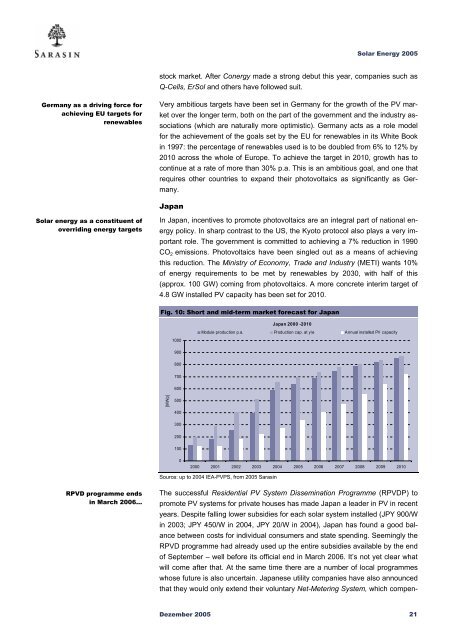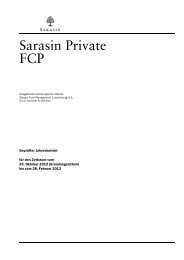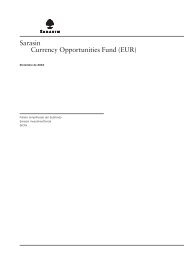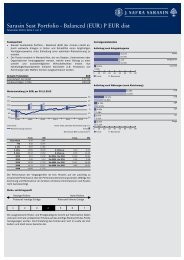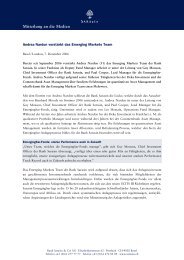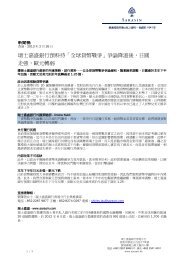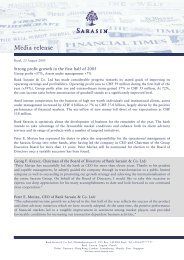Sustainability Report - Bank Sarasin-Alpen
Sustainability Report - Bank Sarasin-Alpen
Sustainability Report - Bank Sarasin-Alpen
You also want an ePaper? Increase the reach of your titles
YUMPU automatically turns print PDFs into web optimized ePapers that Google loves.
Solar Energy 2005<br />
stock market. After Conergy made a strong debut this year, companies such as<br />
Q-Cells, ErSol and others have followed suit.<br />
Germany as a driving force for<br />
achieving EU targets for<br />
renewables<br />
Very ambitious targets have been set in Germany for the growth of the PV market<br />
over the longer term, both on the part of the government and the industry associations<br />
(which are naturally more optimistic). Germany acts as a role model<br />
for the achievement of the goals set by the EU for renewables in its White Book<br />
in 1997: the percentage of renewables used is to be doubled from 6% to 12% by<br />
2010 across the whole of Europe. To achieve the target in 2010, growth has to<br />
continue at a rate of more than 30% p.a. This is an ambitious goal, and one that<br />
requires other countries to expand their photovoltaics as significantly as Germany.<br />
Japan<br />
Solar energy as a constituent of<br />
overriding energy targets<br />
In Japan, incentives to promote photovoltaics are an integral part of national energy<br />
policy. In sharp contrast to the US, the Kyoto protocol also plays a very important<br />
role. The government is committed to achieving a 7% reduction in 1990<br />
CO 2 emissions. Photovoltaics have been singled out as a means of achieving<br />
this reduction. The Ministry of Economy, Trade and Industry (METI) wants 10%<br />
of energy requirements to be met by renewables by 2030, with half of this<br />
(approx. 100 GW) coming from photovoltaics. A more concrete interim target of<br />
4.8 GW installed PV capacity has been set for 2010.<br />
Fig. 10: Short and mid-term market forecast for Japan<br />
Japan 2000 -2010<br />
Module production p.a. Production cap. at y/e Annual installed PV capacity<br />
1000<br />
900<br />
800<br />
700<br />
600<br />
[MWp]<br />
500<br />
400<br />
300<br />
200<br />
100<br />
0<br />
2000 2001 2002 2003 2004 2005 2006 2007 2008 2009 2010<br />
Source: up to 2004 IEA-PVPS, from 2005 <strong>Sarasin</strong><br />
RPVD programme ends<br />
in March 2006…<br />
The successful Residential PV System Dissemination Programme (RPVDP) to<br />
promote PV systems for private houses has made Japan a leader in PV in recent<br />
years. Despite falling lower subsidies for each solar system installed (JPY 900/W<br />
in 2003; JPY 450/W in 2004, JPY 20/W in 2004), Japan has found a good balance<br />
between costs for individual consumers and state spending. Seemingly the<br />
RPVD programme had already used up the entire subsidies available by the end<br />
of September – well before its official end in March 2006. It’s not yet clear what<br />
will come after that. At the same time there are a number of local programmes<br />
whose future is also uncertain. Japanese utility companies have also announced<br />
that they would only extend their voluntary Net-Metering System, which compen-<br />
Dezember 2005 21


